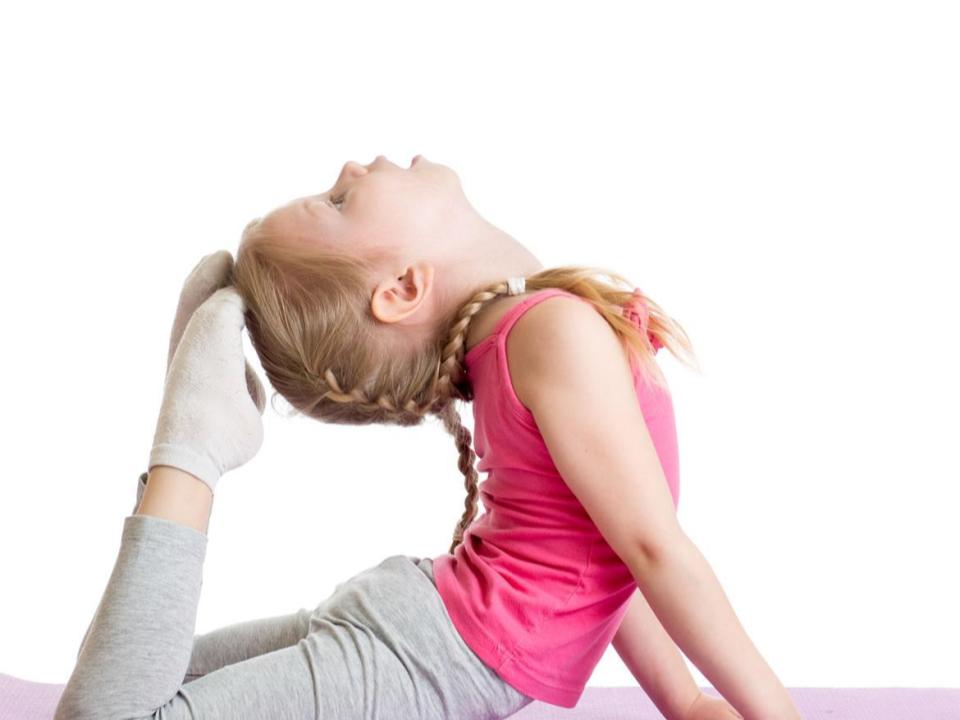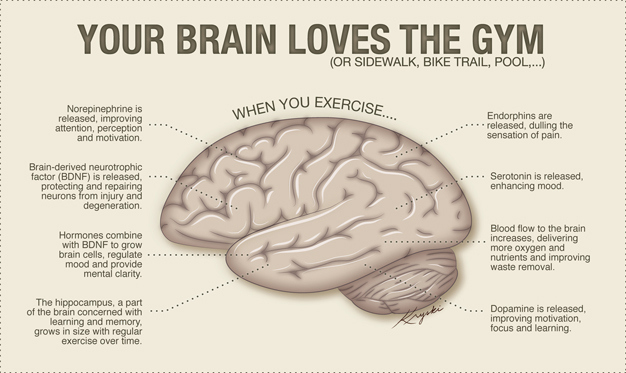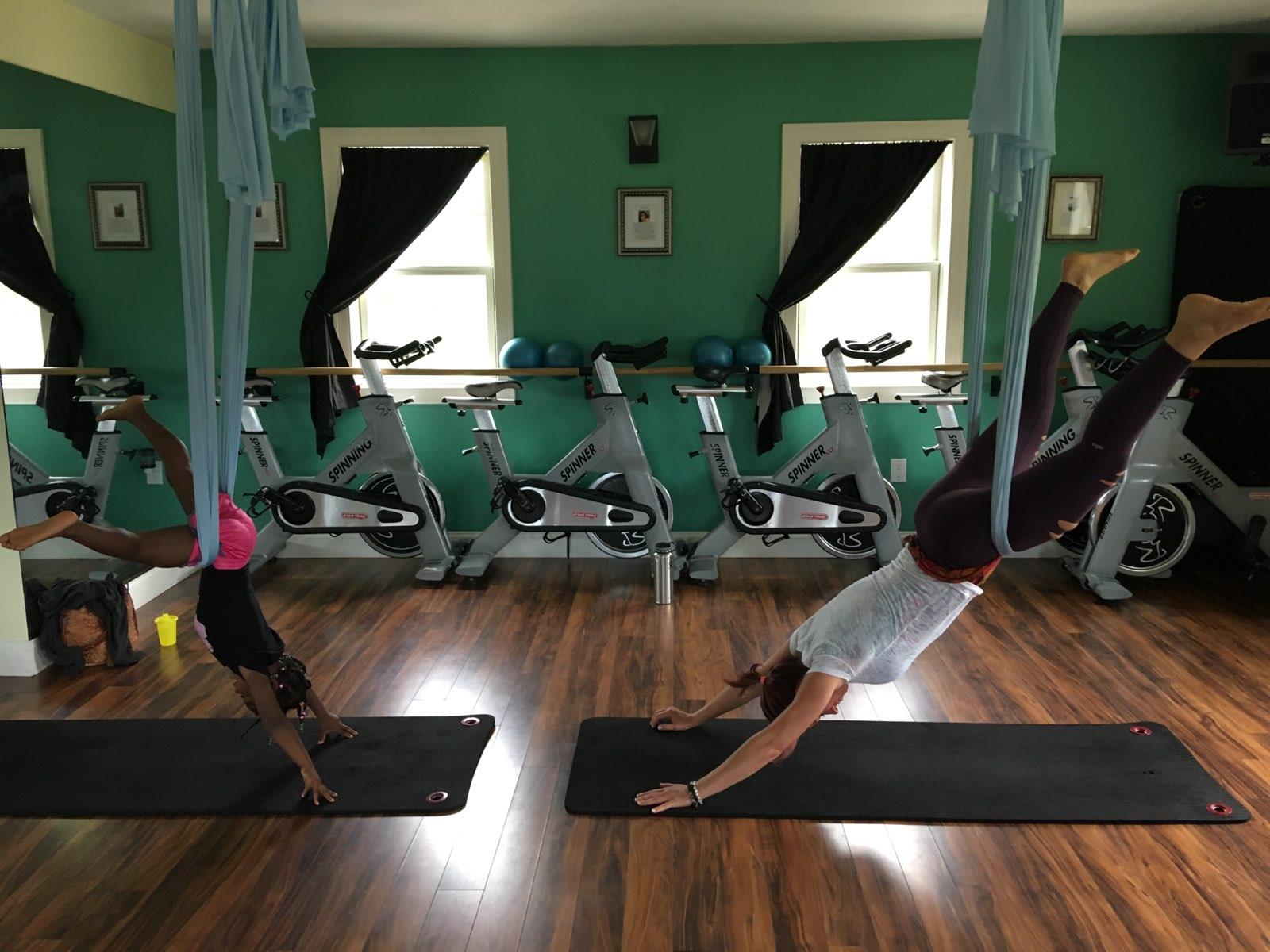
EXERCISE AND BEHAVIOR (MOVEMENT)
It is well known that exercise has great benefits for our bodies, but lesser known are exercises’ mental health and behavioral benefits. Regular exercise can have a positive impact on depression, anxiety, ADHD and troublesome behaviors (Robinson, Segal & Smith, 2018). It can also help to relieve stress, improve memory, improve sleep quality and boost overall mood (Robinson, Segal & Smith, 2018). Research shows that even modest amounts of exercise can make a difference (Whitney, 2018).

BENEFITS OF EXERCISE
When the body is engaged in exercise or movement, the heart beats faster, more blood is circulated throughout the body and brain and breathing becomes faster and deeper, which increases oxygen to the brain and muscles (Coury, 2013). Additionally, exercise increases the release of neurotransmitters that include endorphins and dopamine, which can greatly affect the brain’s functioning (Gingell, 2018). Exercise also helps to lubricate the joints for those that feel lethargic or suffer from autoimmune disorders. Music, if used when exercising, can also be beneficial as listening to music helps to engage all areas of the brain. Exercise can help the entire body, including the brain, function at its best (Gingell, 2018).
Exercise has been shown to have measurable benefits for individuals with autism and other neurodevelopmental disorders; individuals with learning disabilities or difficulties, those with emotional disturbances and behavioral regulation deficiencies and those who struggle with anxiety, depression and other mental health disorders (Coury, 2013).
Exercise also has important effects on the vagus nerve. Exercise helps to open the vagus nerve, which plays a role in social connection and helps to prohibit the amygdala from being triggered (Fallis, 2017).

Exercise has benefits for all children, any and all abilities, and of all ages!

ATTENTION: Several studies have researched the effects of exercise in children and adults with attention hyperactivity disorder [ADHD]. They consistently shown clear evidence that exercise improves concentration and organizational skills (Coury, 2013). There also seems to be a link between exercise and attention; after exercise: students are sharper, more attentive, less impulsive and fidgety and sustain their attention longer (Powell, 2018).

BEHAVIOR: Other studies have shown that structured exercise or movement breaks during the day help to ease children and teenagers behavioral issues in the classroom. According to a recent study, children who participated in regularly scheduled exercise throughout the day were about one-third to 50 percent less likely to act out in class and were less likely to be taken out of the classroom for unacceptable behavior (Heasley, 2017). Researchers believe that when children participate in exercise, it changes where the brain is directing its resources; meaning that instead of activity being seen in areas of the brain that focus on worry, the brain is more active in areas that relate to coordination and focus (Norton, 2017). Additionally, exercise releases neurotransmitters in the brain that help to improve an individual’s self-regulation, meaning they have an increased ability to control their behavior, which is a transferable skill that reflects in the child’s classroom performance (Heasley, 2017).
Intense exercise may be beneficial for teenagers as intensity increases, hormones can be released which are similar to adrenaline (Black, Hochman & Rosen, 2013). These hormones cause the teenager to feel as if they are engaging in risk behavior, which their bodies crave as a part of their development. Exercise can be used to help deal with these feelings in a safe way.

MOOD: Regular exercise can act as a mood booster, and the link between the two is very strong. The positive mood enhancing effects of exercise can be felt within about five minutes of moderate exercise, so the beneficial effects will take place almost immediately (Whitney, 2018). Exercise helps to boost your mood on a chemical level.
When you begin exercising and your heart rate rises, it triggers the body’s fight or flight response, which causes the brain to release a chemical called brain-derived neurotrophic factor which protect neurons from the anticipated effects of a threat (Whitney, 2018). The brain also releases endorphins to numb the anticipated pain and to assist peak performance (Weir, 2011). These chemicals that are released in the brain also induce feelings of well-being (Weir, 2011). Endorphins can cause euphoria and brain-derived neurotrophic factor promotes a sense of clarity (Whitney, 2018). When you exercise and your brain releases these chemicals, your brain returns to baseline to allow you to respond most effectively to perceived threats (Weir, 2018).
This is why after we exercise we often feel a better sense of well-being and are able to think more clearly. The key to prolonging these mood boosting effects is not longer periods of exercise, but instead, more frequent exercise (Whitney, 2018). Studies have shown that the greatest mood enhancement effects are apparent in those that participate in just 20 minutes of exercise per day (Whitney, 2018).
By making physical exercise a daily habit, we are training the brain to respond with feelings of happiness and creating a self-reinforcing habit that is motivated by positive feelings.

ANXIETY: Researchers have also explored exercise as a tool for treating and preventing anxiety. When we experience anxiety, our nervous system jumps into action, setting off the fight or flight response. This can cause reactions such as sweating, dizziness and an increased heart rate (Weir, 2018). People who regularly experience anxiety often respond to these sensations fearfully. When a person who experiences anxiety participates in regular exercise, they will experience many of the same anxiety reactions; increased sweating, faster heart rate, in response to their exercise activity. Additionally, it is challenging for the body to trigger the amygdala and set off the fight or flight response when serotonin and endorphins are being released. When participating in a daily exercise routine, it acts almost like an exposure treatment and over time people can learn to associate their symptoms with safety instead of danger (Weir, 2018).

ENCOURAGING EXERCISE
So what can we do to encourage our children, clients and students to exercise daily?
- Consider your child’s preferences to find a fun activity – Help your child find a sport that she enjoys (jogging, bike riding, swimming, yoga, etc.). The more she enjoys the activity, the more likely she will continue it.
- Choose an activity that is developmentally appropriate – For example, a 7 year old is not ready for weight lifting or a 3 mile run, but sledding, soccer, bicycle riding and swimming are all appropriate activities.
- Be a role model – Children who regularly see their parents enjoying sports and physical activity are more likely to do so themselves.
- Play with your child – Help your child learn a new sport. Joining your child in an exercise activity is a great way to reinforce their healthy choices and to make exercise fun. Get the entire family involved, it is a great way to spend time together!
- Make time for exercise – Some children are so over scheduled with schoolwork, lessons and other extracurricular activities that they do not have time for exercise. Try to start a routine with your child upon waking to make sure they get some physical activity each and everyday. In the classroom, scheduling small ‘movement breaks’ throughout the day is a great way to make time for exercise.
References
Black, A., Hochman, E., & Rosen, M. (2013). Effects of competitive exercise on risk-taking in adolescents. Retrieved from: https://www.ncbi.nlm.nih.gov/pmc/articles/PMC3993524/
Coury, D. (2013). Can exercise improve behavior? Help encouraging child who has Autism. Retrieved from: https://www.autismspeaks.org/expert-opinion/can-exercise-improve-behavior-helP-encouraging-child-who-has-autism
Fallis, J. (2017). How to stimulate your vagus nerve for better mental health. Retrieved from:https://www.optimallivingdynamics.com/blog/how-to-stimulate-your-vagus-nerve-for-better-mental-health-brain-vns-ways-treatment-activate-natural-foods-depression-anxiety-stress-heart-rate-variability-yoga-massage-vagal-tone-dysfunction
Gingell, S. (2018). How your mental health reaps the benefits of exercise. Retrieved From: https://www.psychologytoday.com/us/blog/what-works-and-why/201803/how-your-mental-health-reaps-the-benefits-exercise
Heasley, S. (2017). Aerobic exercise self-regulation behavior. Retrieved from: https://www.yourtherapysource.com/blog1/2017/01/12/aerobic-exercise-self-regulation-behavior/
Norton, A. (2017). Exercise: an antidote for behavioral issues in children? Retrieved From: https://www.cbsnews.com/news/exercise-an-antidote-for-behavioral-issuesin-children/
Powell, A. (2018). Giving kids a running start. Retrieved from: https://news.harvard.edu/gazette/story/2018/03/harvard-study-tests-impact-of-k-8-exercise-program/
Robinson, L., Segal, J., & Smith, M. (2018). The mental health benefits of exercise. Retrieved from: https://www.helpguide.org/articles/healthy-living/the-mental-health-benefits-of-exercise.htm/
Weir, K. (2011). The exercise effect. Retrieved from: https://www.apa.org/monitor/2011/12/exercise.aspx
Whitney, D. (2018). Exercise: Nature’s Mood Enhancer. Retrieved from: https://psychcentral.com/blog/exercise-natures-mood-enhancer/


Excellent article – thank you!
Hi! I’m at work surfing around your blog from my new iphone 4! Just wanted to say I love reading your blog and look forward to all your posts! Carry on the outstanding work!